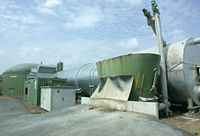
Photo from wikipedia
Objective This study was aimed at evaluating effects of cattle breed resources and alternative mixed-feeding practices on meat productivity and emission intensities from household farming systems (HFS) in Daklak Province,… Click to show full abstract
Objective This study was aimed at evaluating effects of cattle breed resources and alternative mixed-feeding practices on meat productivity and emission intensities from household farming systems (HFS) in Daklak Province, Vietnam. Methods Records from Local Yellow×Red Sindhi (Bos indicus; Lai Sind) and 1/2 Limousin, 1/2 Drought Master, and 1/2 Red Angus cattle during the growth (0 to 21 months) and fattening (22 to 25 months) periods were used to better understand variations on meat productivity and enteric methane emissions. Parameters were determined by the ruminant model. Four scenarios were developed: (HFS1) grazing from birth to slaughter on native grasses for approximately 10 h plus 1.5 kg dry matter/d (0.8% live weight [LW]) of a mixture of guinea grass (19%), cassava (43%) powder, cotton (23%) seed, and rice (15%) straw; (HFS2) growth period fed with elephant grass (1% of LW) plus supplementation (1.5% of LW) of rice bran (36%), maize (33%), and cassava (31%) meals; and HFS3 and HFS4 computed elephant grass, but concentrate supplementation reaching 2% and 1% of LW, respectively. Results Results show that compared to HFS1, emissions (72.3±0.96 kg CH4/animal/life; least squares means± standard error of the mean) were 15%, 6%, and 23% lower (p<0.01) for the HFS2, HFS3, and HFS4, respectively. The predicted methane efficiencies (CO2eq) per kg of LW at slaughter (4.3±0.15), carcass weight (8.8±0.25 kg) and kg of edible protein (44.1±1.29) were also lower (p<0.05) in the HFS4. In particular, irrespective of the HSF, feed supply and ratio changes had a more positive impact on emission intensities when crossbred 1/2 Red Angus cattle were fed than in their crossbred counterparts. Conclusion Modest improvements on feeding practices and integrated modelling frameworks may offer potential trade-offs to respond to climate change in Vietnam.
Journal Title: Asian-Australasian Journal of Animal Sciences
Year Published: 2017
Link to full text (if available)
Share on Social Media: Sign Up to like & get
recommendations!